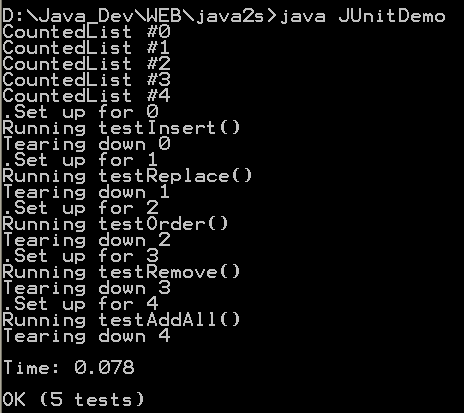Simple use of JUnit to test ArrayList

// : c15:JUnitDemo.java
//Simple use of JUnit to test ArrayList
//{Depends: junit.jar}
//From 'Thinking in Java, 3rd ed.' (c) Bruce Eckel 2002
//www.BruceEckel.com. See copyright notice in CopyRight.txt.
import java.util.*;
import junit.framework.*;
//So we can see the list objects being created,
//and keep track of when they are cleaned up:
class CountedList extends ArrayList {
private static int counter = 0;
private int id = counter++;
public CountedList() {
System.out.println("CountedList #" + id);
}
public int getId() {
return id;
}
}
public class JUnitDemo extends TestCase {
private CountedList list = new CountedList();
// You can use the constructor instead of setUp():
public JUnitDemo(String name) {
super(name);
for (int i = 0; i < 3; i++)
list.add("" + i);
}
// Thus, setUp() is optional, but is run right
// before the test:
protected void setUp() {
System.out.println("Set up for " + list.getId());
}
// tearDown() is also optional, and is called after
// each test. setUp() and tearDown() can be either
// protected or public:
public void tearDown() {
System.out.println("Tearing down " + list.getId());
}
// All tests have method names beginning with "test":
public void testInsert() {
System.out.println("Running testInsert()");
assertEquals(list.size(), 3);
list.add(1, "Insert");
assertEquals(list.size(), 4);
assertEquals(list.get(1), "Insert");
}
public void testReplace() {
System.out.println("Running testReplace()");
assertEquals(list.size(), 3);
list.set(1, "Replace");
assertEquals(list.size(), 3);
assertEquals(list.get(1), "Replace");
}
// A "helper" method to reduce code duplication. As long
// as the name doesn't start with "test," it will not
// be automatically executed by JUnit.
private void compare(ArrayList lst, String[] strs) {
Object[] array = lst.toArray();
assertTrue("Arrays not the same length", array.length == strs.length);
for (int i = 0; i < array.length; i++)
assertEquals(strs[i], (String) array[i]);
}
public void testOrder() {
System.out.println("Running testOrder()");
compare(list, new String[] { "0", "1", "2" });
}
public void testRemove() {
System.out.println("Running testRemove()");
assertEquals(list.size(), 3);
list.remove(1);
assertEquals(list.size(), 2);
compare(list, new String[] { "0", "2" });
}
public void testAddAll() {
System.out.println("Running testAddAll()");
list.addAll(Arrays.asList(new Object[] { "An", "African", "Swallow" }));
assertEquals(list.size(), 6);
compare(list,
new String[] { "0", "1", "2", "An", "African", "Swallow" });
}
public static void main(String[] args) {
// Invoke JUnit on the class:
junit.textui.TestRunner.run(JUnitDemo.class);
}
} ///:~
Related examples in the same category